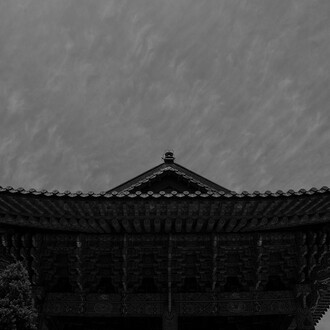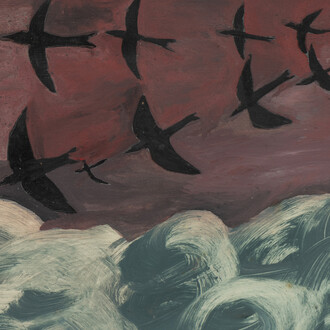Marko Stout’s exhibition, “Infinite Orbs”, opening at Kate Oh Gallery on November 27, 2022, is in many ways a continuation of themes implored by the Hypnotiq exhibition just a few months earlier. But where Hypnotiq art practice engages glistening three-dimensional objects, many of which bear witness to and participate in transhumanist themes and commercial culture, Stout’s is a portraiture practice. If this is pop art, it is explicitly the portraiture side of pop art. Indeed, Stout’s work could readily don the pages of Vogue and Harpers Bazaar, bringing him closer to artistic contemporaries like Hassan Hajjaj than to Warhol. Pop art, however, does not seem to capture the entirety of Stout’s work.
This is because there is a marked sense of the fantastical and ethereal, proffered in perpetuity to the hyperreal, that delineates Stout’s work. This airy film is not to be found in Warhol, Hynotic, or Hajjaj. And this resonance is best found amongst the eponymous “orbs” scattered throughout Stout’s portraits, many of which are flaxen and refract light, neatly posited before the model’s clean, shapely face. These models, generally captured from the collar up, are also often dotted in piercings and small, dainty demarcations—tar-like dots creeping a serpentine arrow down the shoulders. In one particularly interesting piece, a golden heart floats before the model’s upper chest. Sumptuous gold also papers over the background, twinkles of guild striking and lucent. These are not lamps guiding our view from adumbrated corners but all-pervading scintillation, striking the balance of the entire portrait agleam. If there is really an anchor to pop art proper that is to be found here, it is with the commercial aesthetics of burnished, lustrous women whose glossed and polished hair is pulled back in the mode of a runway model. Stout pairs representational realism, which characterizes his portraiture, with the otherworldy irradiance of relucent, polychrome orbs, hearts, and background palettes.
More than anything, it is the term “hyperreal” that crowns Stout’s work. It is also this “hyperreality” that makes them incredibly timely considering our epoch’s ambient narcissism, where tik-tok self-celebritization and the notion of the idol has become so diffuse that it serves as an asymptotic beacon for grand swathes of the populous, young and old. Only the effortful hermetic can evade its talons. “Hyperreality,” as popularized by Baudrillard, is a theoretical device that captures the fragmented and fractured nature of postmodernity, although, as argued by Christine Buci-Glucksmann, it also was characteristic of the baroque period. Arguably, “hyperreality” also pervaded the work of art deco artists like Tamara de Lempicka, Aubrey Beardsley, Gerda Wegener, and Alphonse Mucha, all artists of decorative, sensual celebration. Such sensual celebration undoubtedly is of a piece with Stout’s works. What binds these variegated pieces together is an acute awareness and participation in the artificial, socially constructed nature of reality (i.e., its “hyperreality”) and a sensitivity to the precarity of the human condition. But ever so often, the former subsumes the latter, with precarity lending a hand to exuberant conviviality. Whether Stout’s works critique capitalism is, as was the case with Hynotiq’s sculptures, an empty question—after all, in the era of the “death of the author” and the “birth of the reader” (or, in the case of the visual arts, the perceiver), the critique of a work of art is decisively rooted in interpretive interpolation. We bear meaning by way of cognitive contemplation, such that the author’s intentions are of a lesser importance than our reception. In turn, how we receive and interpret art is just as central, if not more important, than the meaning of an artwork that the artist meant to impart.
At this point, Baudrillard’s analyses of the role of consumption and the masses bear repeating, such that we might pin down the “hyperreal”. As Buci-Glucksmann notes, in the Shadow of the Silent Majorities (1983), Baudrillard argues that capitalism is impervious to political change and philosophical critique, as: …the mass acts as a black hole which absorbs and destroys all the attacks directed at it. The creation of the mass by modern technologies of communication means that modern society is a kaleidoscope of whirling symbols and values, a simulated world of signs which are divorced from, and no longer connected with, any sense of social reality. (1994: 25)
These whirling symbols and values are made literal in Stout’s iridescent hovering orbs. In Baudrillard’s America (1988), he goes on to suggest that the United States, as “the leading edge of hyperreality, transforms the social universe into a system of simulated cultures” (Buci-Glucksmann 1994: 25). Baudrillard well presaged the contemporaneous moment, where celebrities readily run for political office (e.g., Trump, Dr. Oz, Hershel Walker) or politicans mold themselves into celebrities vis-à-vis popular talk-show appearances, MET Gala “controversies”, and the like. For Baudrillard, our political reality can no longer be distinguished from reality television, with the masses consuming news reports of political “violence, street warfare and gangsterism in the same way as they consume fictions and fantasies about simulated violence” (ibid.). Stout’s work may not directly make such pointed references to our media landscape and the characters that populate it, but it is still steeped in the aesthetics of hyperreality. This is most pronounced in symbols like the flaxen heart and bouncing ethereal orbs, which underscore the new media technological apparatuses that supply commercial culture. With the advent of smart phone applications that enhance and edit at a thumb’s flicker, selfies are rapidly enhancing and transfigured beyond the fixture of ordinary earthly objects. Where Lempicka, Mucha, Wegener, and Beardsley remained affixed to illustration and painting to engage such transfiguration, Stout’s aesthetics of hyperreality brings us into more direct contact with it.
(Text by Ekin Erkan)
















